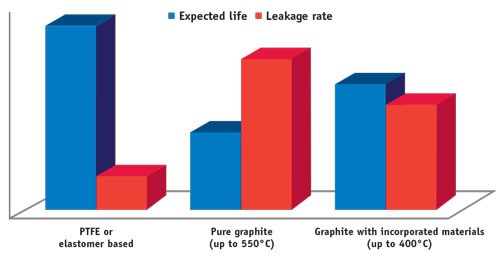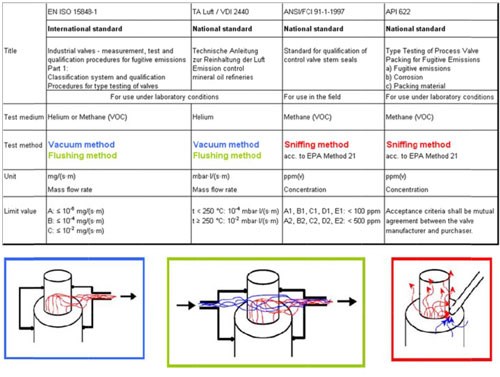Regulators’ monitoring of emissions has forced industries to either implement proactive programs of leak detection and repair (LDAR) or deal with implications of non-compliance, which include fines and consent decrees. In either case, advanced sealing technology can help: It allows an entity to avoid non-compliance or adhere to the low-emission consent decrees.
EMISSION LEVELS
Low emission consent decrees are often specified at less than 100 parts per million (ppm).1 However, local regulations, plant-specific regulatory action and potential long-term lowering of governmental agency acceptable limits mean that in the near future, sealing technology resulting in valve emissions at levels below 500 ppm will not be adequate. With valves accounting for 60% of all non-compliance, conventional valve packing will not be an acceptable emissions solution by itself moving forward.2
Meanwhile, emissions are a greater technological challenge when dealing with control valve sealing because control valves are subject to a greater degree of mechanical cycling than manual valves. Even in the most difficult test conditions, manual valves see only a maximum of 5,000 mechanical cycles, and in actual service, a manual valve will undergo reconditioning and repair before it ever reaches that 5,000-cycle mark. Test conditions based upon industry standards for control valves, however, are often 100,000 cycles or more.
The overall effectiveness of the seal for emissions can be determined by industry test criteria such as ANSI/FCI 91-1,3 TA Luft/VDI 2440 or DIN EN ISO 15848-1.4 Emissions detecting methods used in testing as well as in enforcing valve sealing methods generally fall into one of two categories, vacuum or sniffing. The vacuum method, which is commonly used in Europe, is a collection method that measures the amount of leakage into a vacuum chamber. This method is used in test procedures VDI 2440 and ISO 15848, and typically uses helium as the test medium (Figures 1 and 2).
Sniffing is used by the U.S. Environmental Protection Agency (EPA) through method 21. It uses an air sampling method to determine concentration of volatile organic compounds. Methane is the common test medium, and this method of testing is used for ANSI 91-1 and API 622.5
The reason there are two emissions detection methods is largely because emissions are regulated differently by different national enforcement entities. It is important to note that data collected from the two methods should not be used comparatively for leakage evaluation—there is no direct conversion from one method to the other. Also, the matter is complicated by the fact that the air concentration detection methods typically used in the U.S. can be influenced by environmental and background factors, which is not the case with direct leak collection methods commonly used by European authorities. This difference is complicated even further by the fact that test media have different chemical and physical properties, and the units of measurement used in testing have no direct conversions.
SNIFFING
From the perspective of the ANSI/FCI 91-1, the test evaluates packing for 100,000 full mechanical cycles with three temperature cycles while under pressure to achieve the highest level of leakage prevention. These methane emissions measurements are made per EPA method 21. While this test is designed for packing, it also can be used for comparing competing products or technologies such as metal bellows seals.
Given the two LDAR certifying means presented by EPA, an equivalent time period to the 100,000 cycles for a process operating under good engineering practices would be five years. The overall success of this test, as with any part of an emissions reduction program, should be reviewed by field monitoring to assure emissions are below required levels. With well-designed metal bellows, the emissions resulting from the bellows seal should measure at a constant 0 ppm.
Packing in valves is intended to seal the area between the stem and the bonnet. Packing materials typically are PTFE, carbon or graphite in different arrangements designed to reduce relaxation and mechanical damage over cycles and time. “Live loading,” a term used for the force of some springs, is often implemented as a way to reduce relaxation of the packing set. This is done because relaxation results in packing load loss and increased leakage. A key limitation of over-tightened packing by gland follower or bushing is over-expansion of the packing radially, which increases packing wear and limits stem movement, thereby also limiting emissions reduction.
Besides valve stem-packing systems, a metal bellows seal can be used to mitigate valve stem leakage. While packing has evolved over the years to meet the needs of tight leakage, advanced metal bellows have always represented the ultimate in valve sealing technology. A bellows seal can achieve zero leakage for a lifespan that far exceeds even the most advanced packing. In the past, this zero stem leakage was critical for applications where health and safety were of paramount concern and the higher cost of bellows was justified. In the present, however, metal bellows technology also should be considered for use in any applications with risks to health, safety and the environment sufficient to justify use of the best available technology solution.
FACTORS TO CONSIDER
The external factors that might influence the service life would include proper material selection for construction, suitable implementation of the design method, use of superior manufacturing processes, consideration of adversities that the seal will face, and contemplation of what effects the process medium will have on the seal.
Metal bellows are typically constructed of austenitic stainless steel or a similar corrosion-resistant nickel alloy of high strength. Material considerations are process fluid chemical compatibility, design resiliency, fatigue life and temperature resistance. For example, lethal dry chlorine does not exhibit corrosion problems; however, when it comes in contact with normal air humidity, chlorine becomes aggressive and causes damage to stainless steel. For this reason, Hastelloy C bellows are recommended for chlorine applications instead of standard stainless steel.
A suitable method for bellows design is a multilayer wall construction. When combined with use of higher- strength metal alloys, this multilayer design expands the operating range of the metal bellows seal. The bellows manufacturing process can be either a forming or welding of the metal to the desired pattern. The formed method can be achieved either hydrostatically or mechanically. The welded type is produced by stacking many individual leaf segments that are welded together at the outer edges. With increased points of failure, the hydrostatically formed and welded type of bellows cannot achieve the design level of the mechanically formed bellows.
Detailed attention to process service conditions during the metal bellows design process will allow for better product construction. Operational pressure must be considered in light of the need to assure the integrity of the device when extreme forces are applied. By testing a multi-wall metal bellows to application pressures, the bellows is pressure-rated greater than the valve body rating without danger of collapsing.
REDUCING STRESSES
The quality of masterfully designed metal bellows has been proven by their ability to last for several years of service. Superior design focuses on reducing the amount of stress applied to the bellows seal. The first method in alleviating stress is reducing the total valve travel to decrease movement and external forces. Along that same principle, a second method involves increasing the number of convolutions per unit of measure, which in turn reduces the forces and stress on each individual convolution. By increasing the number of convolutions, small travel is accounted for without fatigue to the metal bellows. This is especially important when only these small movements are required to control the process.
Another method to reduce stress on bellows is to increase the length of the components. A typical rule of thumb is that the bellows should be 10 times the nominal stroke of the valve. In this way, bellows enjoy an exponential increase in service life and give a high amount of trouble-free cycles.
Stress can also be reduced through design. For example, the best way to reinforce the bellows is to design an increased wall thickness via multi-layering while also achieving a uniform wall width throughout the convolutions. In this way a metal bellows seal can be constructed to enhance durability, serviceability and longevity.
CHANGING VIEWS
Most valve stem packing systems today are based upon one of the three packing material groups. The first group is known for producing less friction, longer life and lower leakage at the expense of handling higher temperatures. The second group addresses the higher temperature needs but lacks the advantages of the first packing material. The third group is a hybrid of the prior two materials groups.
Meanwhile, metal bellows can meet the extended temperature range while outlasting and outperforming packing systems. They are pressure-tight, resistant to temperature and corrosion, maintenance-free, reliable, able to achieve long life, and provide a low life-cycle cost compared to all other types of control valve stem-sealing methods.
Manufacturers with close production process control and detailed cycle testing of metal bellows can provide accurate predictions for the expected product life. These bellows are designed and tested to adhere to stroke counts and life expectations typically required of customers as well as the most rigorous testing procedures. State-of-the-art metal bellows have been proven effective throughout the world in thousands of installations, from normal operating conditions to the most extreme temperatures, pressures, flow circumstances and hazardous process conditions. Given that metal bellows have a proven record in lethal service, their ability to meet fugitive emissions requirements should be a certainty.
From a cost view, metal bellows are more expensive than traditional packing methods but the monetary savings provided by reducing the loss of process to the environment, as well as the increase in process uptime with less frequent shutdowns, far outweighs the additional cost. State-of-the-art metal bellows seals are the best available technology solution for valve stem leakage offering optimal fugitive emissions prevention able to exceed regulatory standards and customer requirements.
Joseph Dufresne, MEE, is a research & development engineer for Samson Products, Inc. (www.samson-usa.com). Reach him at jdufresne@samson-usa.com. Calvin Gillis, BSMET, is a senior applications specialist, Samson Controls, Inc. Reach him at cgillis@samson-usa.com.
FOOTNOTES
- Hydrocarbon Processing, Fugitive emissions from valves: Update, 6-1-2011, Wilwerding J, Sage Environmental. http://www.hydrocarbonprocessing.com/Login.aspx
- Environmental Protection Agency Report, 1995
- American National Standards Institute, Standard for Qualification of Control Valve Stem Seals, 2010, ANSI/FCI 91-1 2010
- Deutsches Institut für Normung eV (German Institute for Standardization), Industrial valves – Measurement, test and qualification procedures for fugitive emissions – Part 1: Classification system and qualification procedures for type testing of valves (ISO 15848-1:2006), 2006, DIN EN ISO 15848-1
- Peter Scheermesser, Control and Reduce Fugitive Emissions with Control Valves, Potential Solutions for Environmental Protection, Valve World, June 2011.
RELATED CONTENT
-
The Mighty Steam Trap
The steam trap is the device primarily responsible for automatic discharge of condensate from steam systems. It’s the same today as it was in the early days.
-
Introduction to Pressure Relief Devices - Part 1
When the pressure inside equipment such as boilers or pressure vessels increases beyond a specified value, the excess pressure may result in a catastrophic failure.
-
Best Practices in Pressure-Relief Valve Maintenance and Repair
In their presentation at the Valve Repair Council Repair Meeting & Exhibition, Nov. 1 and 2, 2012, in Houston, Bob Donalson and Kevin Simmons of Pentair Valves & Controls shared valuable information about maintenance and repair programs for pressure-relief valves.











 Unloading large gate valve.jpg;maxWidth=214)


